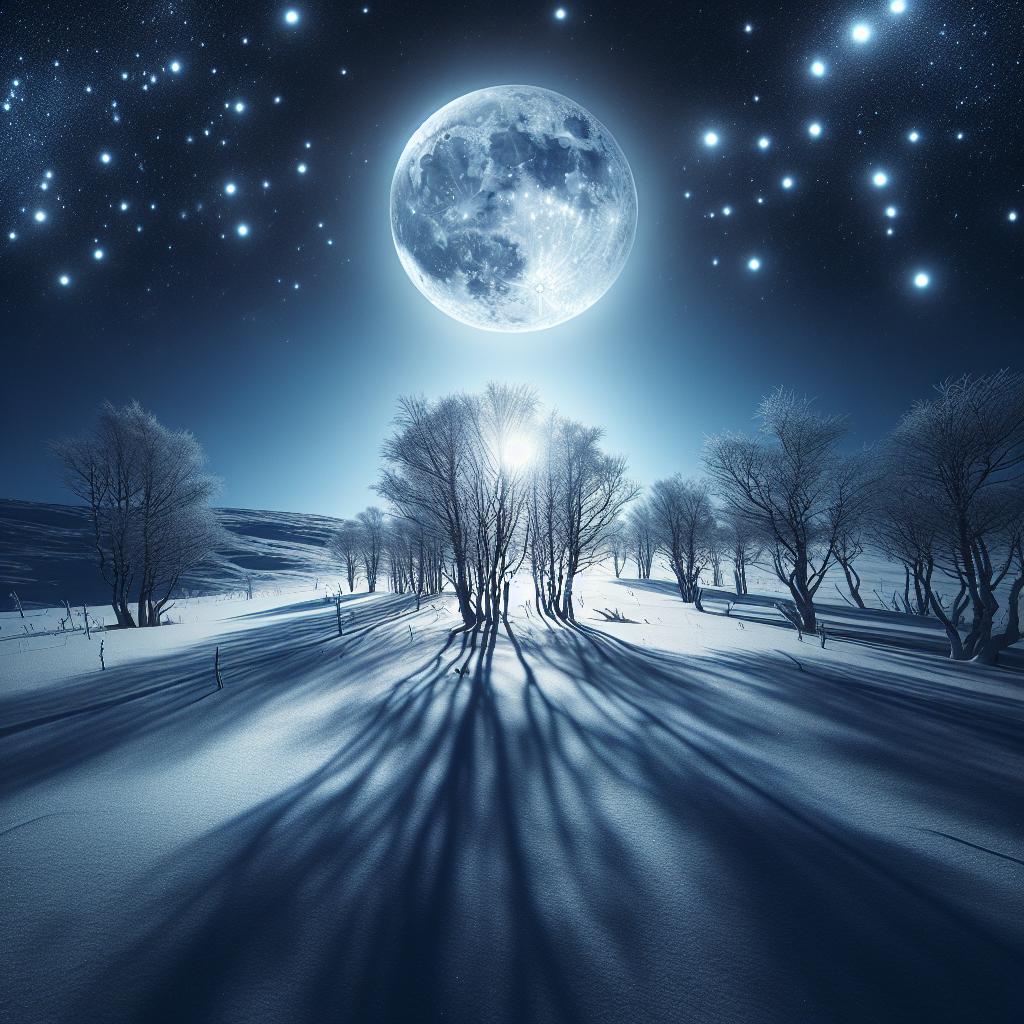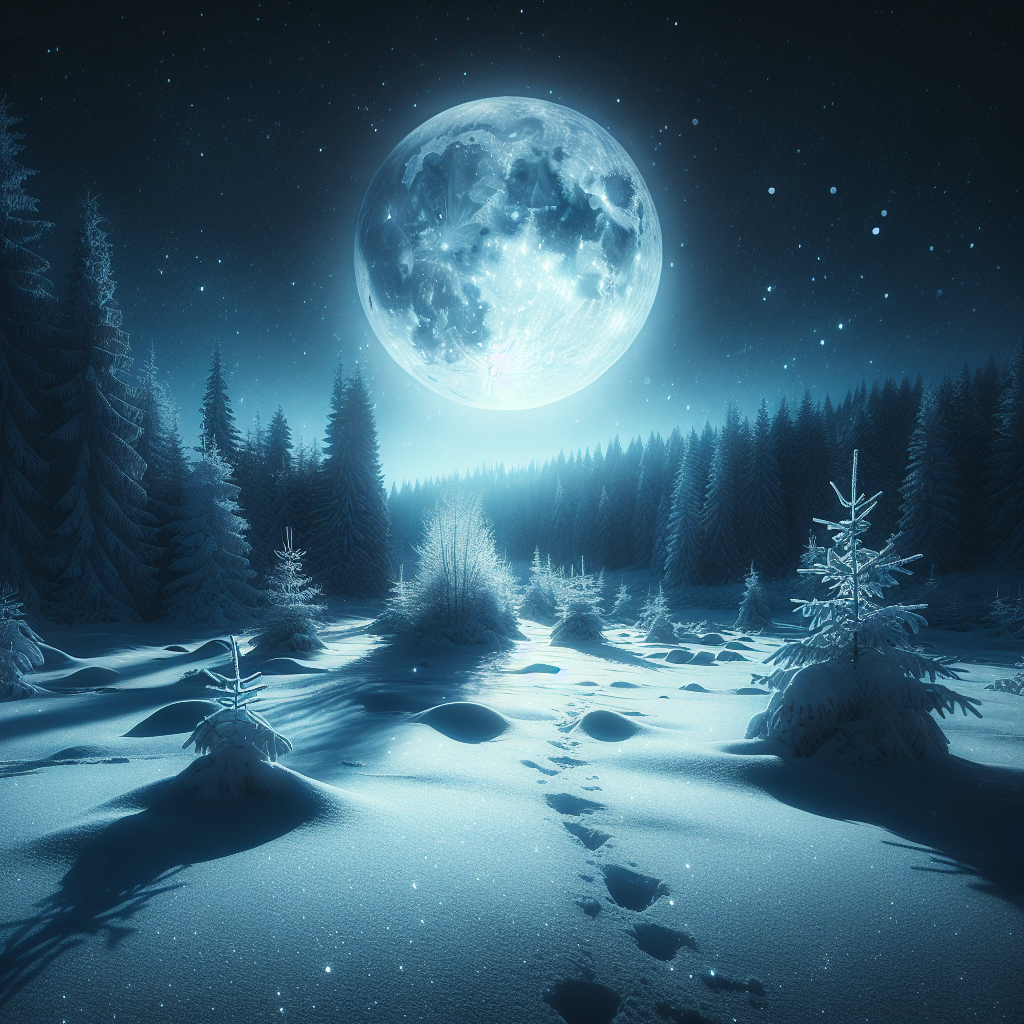As an Amazon Associate I earn from qualifying purchases.
↻
Last updated: December 24, 2025

The full moon in January is often referred to as the Wolf Moon, a name believed to have originated from the Native American tribes and early Colonial Americans who observed wolves howling in hunger outside their villages during the cold and snowy month. Traditionally, the full moon served as an essential time marker for indigenous people, with each moon phase symbolizing different seasonal cycles and activities such as hunting, planting, or harvesting.
Historically, the January full moon has held significance due to its timing after the winter solstice—a period when the nights are long and the landscape is typically shrouded in the stillness of winter. This full moon has also been known as the Old Moon, Ice Moon, or Snow Moon in different cultures, reflecting the prevalent environmental conditions associated with this time of the year. Its appearance was often seen as a beacon in the dark, offering light and orientation during the peak of winter.
In the realm of astronomy, the full moon of January is notable for its trajectory across the sky, which closely mirrors the path of the sun during the summer months in the respective hemisphere. This means that in the Northern Hemisphere, the January full moon will often be higher in the sky, prolonging the duration of moonlight that reaches the surface. Interestingly, the coincidence of a full moon with perigee—when the moon is closest to Earth in its orbit—can result in a Supermoon, a term that has gained popularity in recent years.
Embedded in various cultural and spiritual practices across the world, the January full moon is sometimes seen as a time for reflection, renewal, and setting intentions for the year ahead. Numerous festivals and rituals coincide with the full moon, drawing upon its perceived influence on human behavior and natural phenomena. For instance, some people believe that the full moon can affect sleep patterns and human psychology, although scientific studies on the subject have produced mixed results.
With the advance of technology and urbanization, the January full moon's impact on daily life may not be as pronounced as it once was. However, it still captivates the imagination of many who look up at night. Every year, countless photographers and nature enthusiasts plan special outings to witness the first full moon of the calendar year, often sharing their experiences across social media platforms. This surge in interest has led to a notable increase in public engagement with celestial events, highlighting a collective sense of wonder and a shared human experience with the cosmos.
html
What Is the Significance of January's Full Moon?
The January Full Moon, often known as the Wolf Moon, has a rich tapestry of cultural and spiritual significance that varies among communities around the world. It typically signifies a time of heightened emotion, clarity, and a pivotal moment to reflect on the past while planning for the future. As the first full moon of the new year, it is seen by many as a symbolic occasion that sets the tone for the year ahead. Important for both astronomers and astrologers, the January Full Moon is also an ideal time for stargazing, with its bright appearance offering a beacon of light in the winter sky. To delve deeper into the mysteries and the lore behind January's Full Moon, as well as practical tips on how to observe and celebrate this celestial event, continue reading for a comprehensive exploration.
January's Full Moon, widely recognized as the Wolf Moon, lights up the cold winter sky with its silvery glow, offering a beacon of luminosity during the long nights. This celestial event occurs when the Earth's satellite is fully illuminated by the Sun, appearing as a perfect orb in the sky. Depending on the particularities of the lunar calendar, it can happen at the very beginning of the month or towards the end.
The Wolf Moon holds a place of significance in many cultures. The name itself is believed to have originated with the Native Americans, attributed to the howling of wolves that was often heard during this time of year. The chilling sound of wolves in the night perhaps led to the naming of this January Full Moon, as it coincided with the deep winter when food was scarce, and the predators were more vocal.
Additionally, the January Full Moon has been known by other names according to different traditions. Some European cultures have dubbed it the Ice Moon, while other folklore describes it as the Old Moon. The variety in nomenclature reflects the diversity of cultural responses to this recurring natural phenomenon that breaks the monotony of the long, dark January nights.
In astrology, the January Full Moon is often considered a time for self-reflection, planning, and letting go of the past to embrace the future. It is seen as a particularly auspicious time for setting intentions for the forthcoming lunar year. Astrologers believe that the energy of the full moon brings clarity and illumination to the subconscious, making it a powerful moment for personal growth and spiritual practice.
Astronomically, the January Full Moon provides an opportunity for various scientific studies and observations. Researchers use this time to study the geological features and the climate fluctuations of the moon's surface. The full moon's consistent path around Earth also allows scientists to predict its occurrences with great accuracy, which is valuable for both professional and amateur stargazers.
The January Full Moon's effect on tidal forces is another area of interest. The alignment of the Sun, Earth, and Moon during a full moon exerts a gravitational pull on our planet, occasionally leading to higher than average tides, known as spring tides. These can be predicted with precision and are important for maritime activities, including navigation and fishing.
The lunar spectacle presents not only a marvel for the eyes and a symbol of intrigue but also plays a significant role in the biological rhythms of many organisms. Numerous species, including some breeds of coral, have reproductive cycles that are synchronized with the lunar cycle, particularly the full moon phase.
Regarding photography and lunar observation, the January Full Moon is an excellent subject for both professional astronomers and hobbyists. The generally clear winter air provides sharp, crisp images for those capturing its beauty, and the often snow-covered landscapes can reflect the moonlight, bathing the surroundings in an ethereal glow.
Statistically, the visibility of the January Full Moon varies greatly depending on geographical location and local weather conditions. However, when conditions are favorable, reports suggest nearly 98% of the Earth's population has a chance to observe the January Full Moon, assuming clear skies and no local obstructions. This impressive statistic highlights the widespread appeal and connectivity of experiencing the January Full Moon, tying generations of human observers to the rhythms of the celestial dance.
1. What is January's full moon called?
The January full moon is commonly referred to as the Wolf Moon. This name is believed to have originated with Native American tribes and early colonial Europeans as wolves were heard howling more frequently during this time of year.
2. When can I see the full moon in January?
The specific date and time of January's full moon varies each year. To find out when it will occur, you can check an astronomical calendar or a reliable weather website for exact details based on your location.
3. Is the Wolf Moon a supermoon?
The Wolf Moon can be a supermoon if it coincides with the moon's closest approach to Earth, known as perigee. Whether January's full moon is a supermoon or not depends on the specific alignment and timing of the moon's orbit that year.
4. Are there any special events associated with January’s full moon?
While there are no universal events tied to January's full moon, various cultures and communities may have traditional celebrations or rituals that coincide with the Wolf Moon. Additionally, some people take the opportunity to observe or photograph the full moon as a personal activity.
5. Can January's full moon affect my sleep or behavior?
There is no scientific evidence to support the idea that a full moon, including January's, can significantly affect an individual's sleep patterns or behavior, though some people report feeling different during the full moon phase.
6. How does the full moon in January affect the tides?
The gravitational pull of a full moon, including the one in January, can lead to slightly higher tides, known as spring tides. These tides are typically more pronounced when the moon is closest to Earth, such as during a supermoon.
7. What is the best way to photograph January’s full moon?
To photograph January's full moon, use a camera with manual settings, a tripod for stability, and a long telephoto lens if possible. Aim to capture the moon during twilight for a balanced exposure with the surrounding landscape.
8. Will the weather affect my view of the full moon?
Local weather conditions, such as cloud cover and atmospheric clarity, can affect your view of January's full moon. It's best to check the weather forecast in advance and find a clear spot away from city lights to improve visibility.
9. Is the Wolf Moon the only name for January’s full moon?
No, the Wolf Moon is not the only name for January's full moon. It has various other names given by different cultures and societies, such as the Old Moon, and Ice Moon among others, reflecting local traditions and environments.
10. Can I see the full moon if I'm in the Southern Hemisphere?
Yes, the full moon in January can be seen from both the Northern and Southern Hemispheres, although the time and date at which it appears might differ slightly based on your specific geographic location.

Conclusion
The January Full Moon, often referred to as the Wolf Moon, stood as a beacon in the cold winter sky, reflecting both the frigid conditions and the warmth of the human spirit in its observance. Key points highlighted the Full Moon's significance in various cultures, with many traditions regarding it as a time of introspection and renewal amidst the harshness of winter. Scientifically, we explored its effects on the natural world, such as tidal variations and potential influences on animal behavior, acknowledging the complex interplay between our celestial neighbor and life on Earth.
From a contemporary standpoint, the January Full Moon also represented an opportunity for skywatchers and enthusiasts to come together, either in person or virtually, to appreciate the beauty and consistency of the lunar cycle. Despite the differences in regional celebrations and interpretations, it is remarkable how the Full Moon unifies us in wonder and curiosity. The astronomical details provided insight into the Full Moon's place within the larger cosmos, while the event itself served as a prompt for communal and personal reflection, aligning with the start of the New Year and the hopes and resolutions that come with it. The January Full Moon thus encapsulated a blend of science, culture, and introspection, shining a light on our shared human experience under its glow.
Amazon and the Amazon logo are trademarks of Amazon.com, Inc, or its affiliates.
Continue Your Magical Journey
Free Witchcraft Starter Kit
Get 6 free printable PDFs: grimoire pages, moon calendar, spells, crystals, herbs, and tarot journal.
We respect your privacy. Unsubscribe anytime.
Enhance Your Practice
As an Amazon Associate, I earn from qualifying purchases.

